Key takeaways:
- Establishing a structured timeline reduces stress and enhances accountability in the publication process.
- Utilizing collaborative tools and seeking feedback early can significantly improve manuscript quality and streamline workflows.
- Overcoming challenges like varied submission guidelines and revision feedback requires patience and adaptability.
- Adopting efficient tools such as reference managers and project management software can enhance productivity and organization.
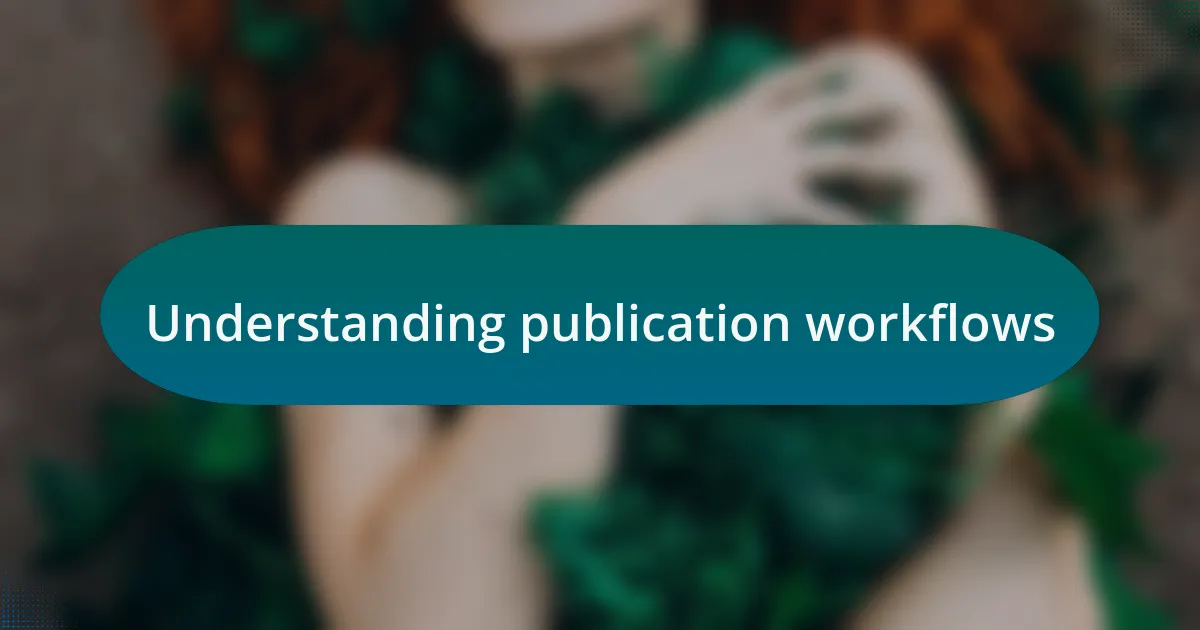
Understanding publication workflows
Understanding publication workflows can feel overwhelming at first, especially when I reflect on my own early experiences. I remember staring at the myriad of steps from drafting a manuscript to navigating peer reviews. It left me wondering, “Where do I even start?” Breaking it down into distinct stages made it far less daunting.
Each phase of the workflow holds significance, from selecting the right journal to responding to reviewer comments. Early on, I didn’t fully appreciate the value of a well-structured plan. I learned that taking the time to outline my submission process meant fewer headaches later—like facing multiple rounds of feedback that could have been avoided. This frustration drove home the point that a detailed workflow isn’t just a checkbox; it’s a roadmap to success.
Moreover, collaboration is a key piece of the puzzle. I vividly recall a project where involving my co-authors early in the draft process transformed the outcome. It made me realize how valuable diverse perspectives are in enhancing the quality of a paper. Have you thought about how collaboration might accelerate your own workflow? Reflecting on these moments can reshape how we take on publication challenges.
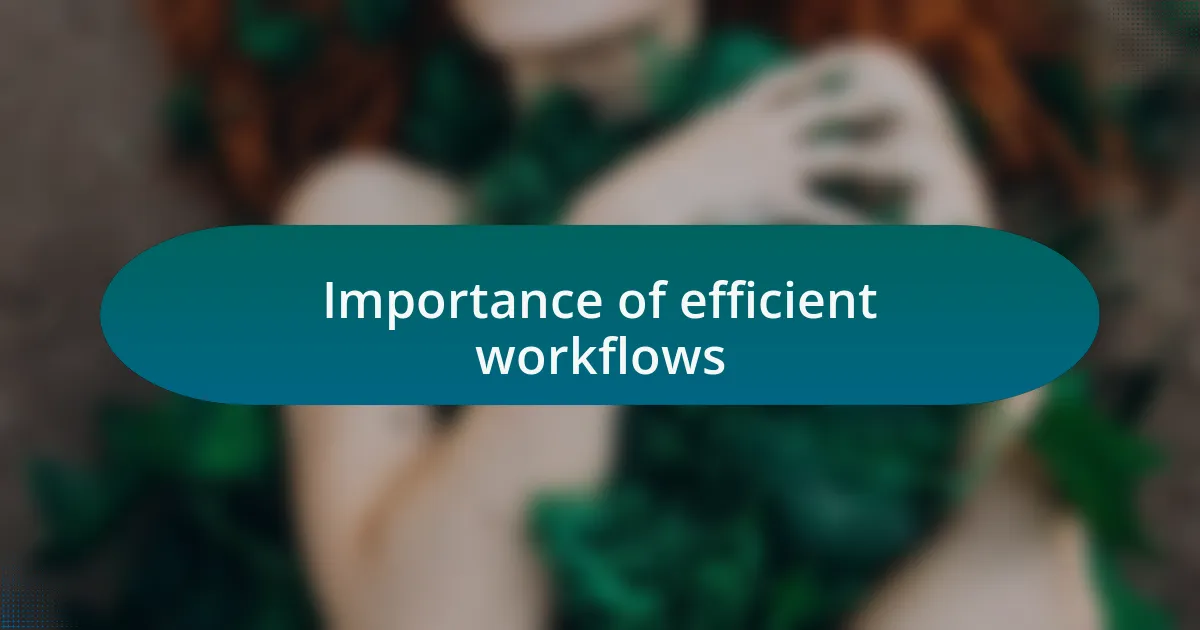
Importance of efficient workflows
Efficient workflows serve as the backbone of any successful publication process. I remember when I first streamlined my submission steps; it felt like a weight lifted off my shoulders. The clarity it brought allowed me to focus more on the quality of my research rather than getting lost in administrative chaos. Have you ever felt the stress of disorganization? A smooth workflow can transform that anxiety into confidence.
When each task is clearly defined, it encourages accountability. In one of my projects, I assigned specific roles to my team members early on, which not only sped up our progress but also fostered a sense of ownership. The excitement during our check-ins was palpable; we celebrated small victories, feeling more connected to the project. Isn’t it fascinating how efficient workflows can enhance team morale and productivity?
Ultimately, the importance of efficient workflows goes beyond time savings. I often think of my initial struggles as lessons learned—each misstep a reminder that patience and planning pay off. I’ve adopted a mantra: “Time spent planning is time earned later.” I’ve found that investing in the workflow process significantly reduces the last-minute panic that can sabotage a submission. How do you measure the effectiveness of your own workflow? Creating that foundation truly sets the stage for successful outcomes.
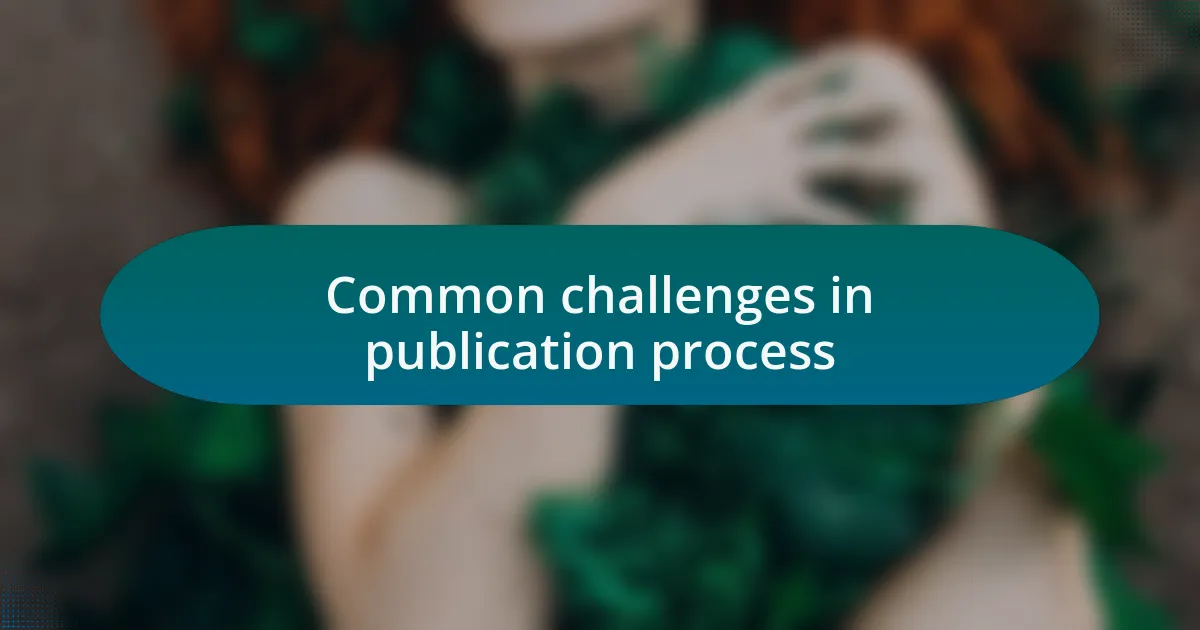
Common challenges in publication process
One of the most common challenges in the publication process is handling revisions. I can recall a time when I submitted a paper that needed extensive edits, which turned out to be a significant source of stress. I felt overwhelmed by the feedback, and it took me longer than expected to navigate the changes. Have you ever found yourself buried under a list of revision comments? Judging the relevance of each suggestion can be tricky, and at times, it’s easy to lose sight of the original intent of your work.
Another obstacle can be the submission guidelines that vary widely between journals. When I first encountered these discrepancies, I spent countless hours adapting my manuscript to fit each journal’s peculiar requirements. The sheer number of details one must pay attention to, from formatting citations to structuring abstracts, can feel daunting. I remember repeatedly double-checking each guideline and feeling a sense of dread while waiting for feedback on whether I missed something crucial.
Additionally, the timeline for publication can often stretch far beyond expectations. I once faced a delay of several months due to unforeseen peer review issues. It was frustrating, to say the least, as I anxiously awaited updates. How do you cope with the uncertainty of publication timelines? For me, it taught me the importance of patience and resilience, knowing that while the waiting can be excruciating, it’s a vital part of the scientific communication process.
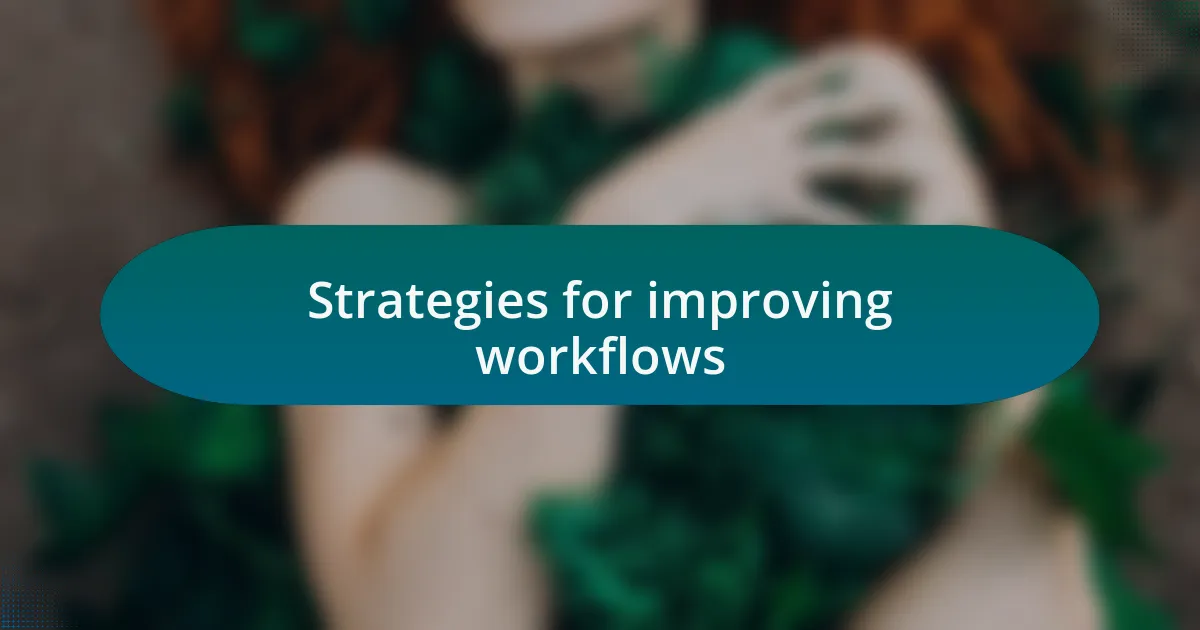
Strategies for improving workflows
It’s crucial to establish a clear timeline for each stage of the publication process. I remember creating a detailed calendar that allowed me to visualize the deadlines for every task, from drafting to submission. This way, I could hold myself accountable and avoid last-minute scrambles. Have you ever felt the panic of realizing a deadline was just around the corner? With a structured timeline, I found that I could maintain focus and reduce stress significantly.
Another effective strategy is to leverage technology to streamline communication with co-authors. When I started using collaborative tools like Google Docs for manuscript drafting, the process became significantly smoother. My co-authors and I could contribute in real-time, providing feedback instantly. Isn’t it amazing how technology can enhance collaboration? This approach not only improved our workflow but also made the writing experience more engaging.
Regularly seeking feedback during the drafting phase can dramatically improve the quality of your work. In my experience, sharing early versions of my manuscript with trusted colleagues led to indispensable insights. Each time I took their suggestions into consideration, I noticed a marked improvement in clarity and coherence. Have you considered how valuable peer feedback could be during your writing journey? Embracing this strategy turned out to be a game-changer for me, transforming my drafts into polished papers ready for submission.
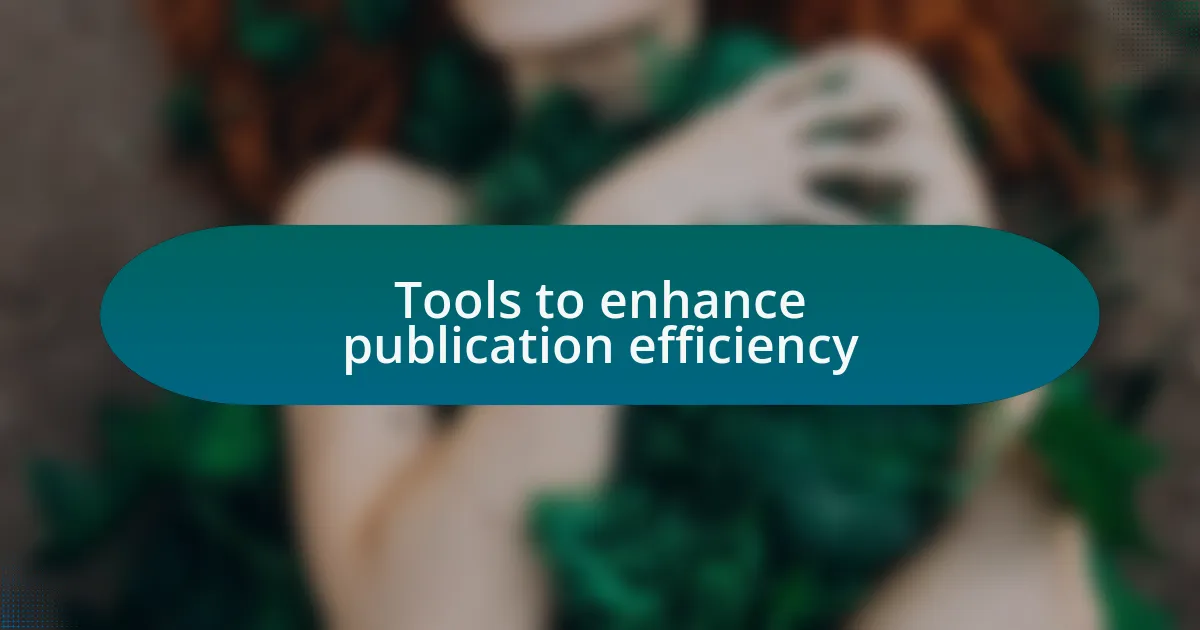
Tools to enhance publication efficiency
When it comes to enhancing publication efficiency, adopting reference management software can be a transformative step. I recall the days when I manually sorted through piles of papers, struggling to keep track of citations. Once I started using tools like Zotero or EndNote, everything changed. Not only did these programs save me countless hours, but they also minimized the risk of errors in my references. Have you ever felt the frustration of misplacing a critical citation? A good reference manager eliminates that stress entirely.
Another game-changing tool for publication efficiency is a project management platform. I integrated Trello into my workflow, which allowed me to visualize tasks and their progress at a glance. The satisfaction of moving a task card from “In Progress” to “Completed” gave me a sense of achievement and motivation. It was like turning a chaotic workflow into a well-oiled machine. Have you considered how organizing your tasks can liberate you from feeling overwhelmed? This simple adjustment made a significant impact on my productivity.
For those of us in research, utilizing automated proofreading tools can be invaluable. I remember a time when I was neck-deep in editing, feeling exhausted and missing out on overlooked typos. Since I started using tools like Grammarly and ProWritingAid, I’ve discovered an extra layer of polish in my manuscripts that I would have otherwise missed. Isn’t it reassuring to have a second pair of eyes, even if it’s digital? These tools not only enhance the quality of my writing but also free up my time to focus on the content itself.

Personal experience and insights
There was a time when the publication process felt like an uphill battle for me. I often found myself lost in endless revisions, unsure if I was hitting the mark with my writing. One day, I decided to share my drafts with peers for feedback before submitting them. The insights I gained were eye-opening; it made me realize the power of collaboration. Have you ever felt hesitant to show your work to others? That moment of vulnerability transformed my approach and helped me refine my style, ultimately elevating my publications to a new level.
As I navigated through publication workflows, I encountered a significant hurdle—time management. I vividly remember a particularly busy period when deadlines loomed, and I could hardly catch my breath. It was during this chaos that I learned the importance of setting strict timelines for myself. By breaking larger tasks into manageable chunks, I not only eased my anxiety but also found joy in progress. Isn’t it amazing how a little structure can breathe life into a daunting project? This practice has become a cornerstone of my workflow, allowing me to produce quality work without feeling overwhelmed.
This journey taught me that improvement is an ongoing process; there’s always room for growth. Reflecting on my experiences, I realized that each small change cumulatively led to a more efficient publication workflow. Has your own journey revealed similar lessons? Embracing this mindset has helped me stay adaptable and open to new methods, ensuring that I continuously enhance my research outputs.

Key takeaways for researchers
When it comes to research publications, I’ve discovered that meticulous organization is essential. I remember one chaotic night, surrounded by a mountain of notes and disorganized files, how overwhelming it felt. Implementing a color-coded system for my documents, where each project had its own designated folder, transformed my approach. This simple change not only saved me hours of searching but also helped me stay focused and on track. Have you ever lost precious time sifting through unorganized work?
Additionally, I’ve come to appreciate the importance of embracing feedback as a gift rather than a critique. Early on in my research, I hesitated to share my drafts, fearing judgment. But one day, I took a leap—I sent a paper to a mentor and was met with constructive suggestions that greatly improved my work. It was a pivotal moment; I realized that seeking input could actually elevate my publications to higher standards. Who would have thought that opening up could lead to stronger results?
Finally, I’ve learned that revisiting and refining my writing is an act of self-care. There was a phase in my research journey where I rushed to submit to meet deadlines, only to regret the hastiness afterward. By integrating a review period in my timeline, I give myself the grace to reflect and make improvements. How about you? Allowing space for reflection has not only enhanced my writing but has also reduced my anxiety during the publication process.